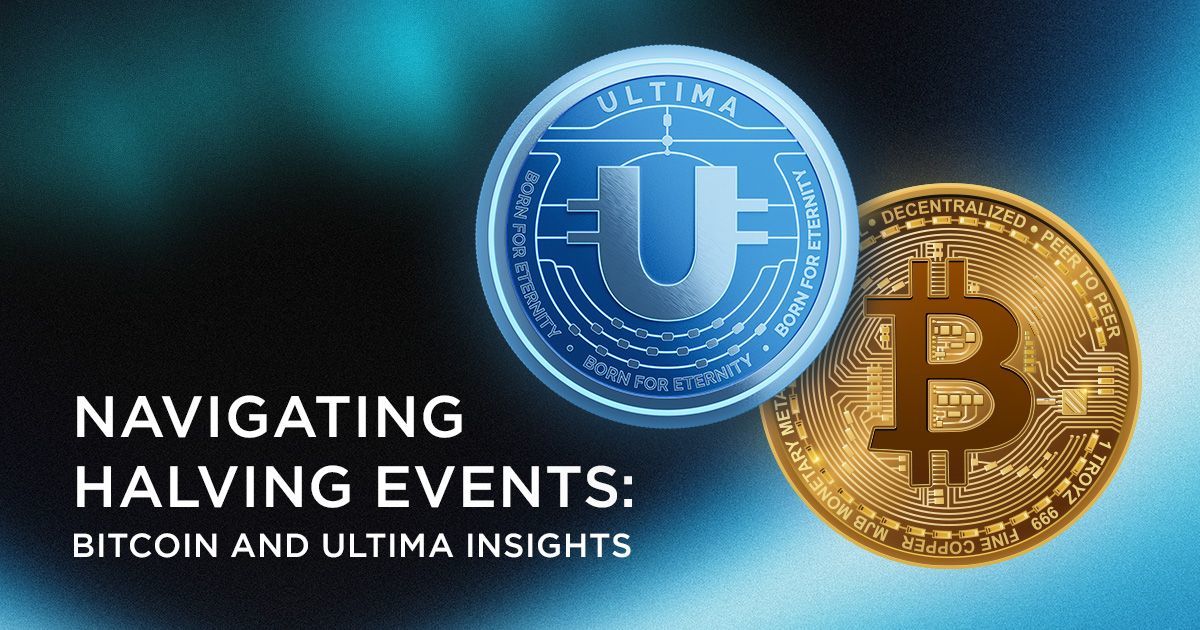







































The Ultimate Guide to ULTIMA Token Halving: How It Corresponds to Bitcoin's and Impacts the Ecosystem
 ULTIMA
ULTIMA

Halving events are crucial in the crypto market realm, impacting the value and scarcity of digital currencies. By reducing the mining reward by half, these events are designed to manage inflation and replicate the value appreciation associated with scarcity, akin to precious metals like gold. Bitcoin, the pioneering cryptocurrency, introduced the concept of halving, serving as a model for others. ULTIMA takes a distinctive approach, integrating halving into its tokenomics with a unique frequency and purpose. Let's delve into these mechanics and explore the similarities and differences in the halving processes of both ULTIMA and Bitcoin.
Understanding Halvings of ULTIMA and Bitcoin: A Primer
At its core, halving is a mechanism used by certain cryptocurrencies to reduce the rate at which new coins are generated. This event occurs at predetermined intervals and results in the halving of the reward given to miners for validating new transactions. The primary rationale behind this mechanism is to create scarcity, thereby potentially increasing the value of the cryptocurrency over time.
Bitcoin's deflationary model involves a four-year event where rewards for mining new blocks are cut in half, akin to the diminishing returns of precious metal mining. This process aims to increase Bitcoin's scarcity, potentially leading to a higher value if demand remains constant or grows.
ULTIMA's approach to halving diverges from Bitcoin's four-year cycle. With an innovative model that schedules halving events annually or every 10 million blocks, ULTIMA introduces a more progressive strategy aimed at creating hyperdeflationary pressure on its token supply. This frequent reduction in daily rewards for SPLIT token holders not only accelerates the scarcity but also amplifies the potential for value appreciation within a shorter time frame.
ULTIMA Token Hyperdeflation vs. Bitcoin Deflation: A Strategic Divergence
The divergence between Bitcoin's deflationary model and ULTIMA's hyperdeflationary strategy presents a fascinating study in the economics of cryptocurrencies. The emission schedules of ULTIMA and Bitcoin provide a stark contrast in their approach to managing supply and incentivizing stakeholders.
Bitcoin's emission schedule is meticulously planned to extend over a century, with halving events occurring every 210,000 blocks, roughly every four years. This gradual reduction ensures a slow and steady approach to reaching its maximum supply cap of 21 million coins.
ULTIMA's annual halving events, coupled with a limited supply of 100,000 units, result in a more accelerated scarcity growth. ULTIMA uses halvings to control token supply, introducing extra scarcity and promoting potential value appreciation. With one of the smallest hard caps in the crypto market, ULTIMA tokens are already inherently scarce, and their halvings create a gradual decrease in tokens availability over time. This creates opportunities for increased demand and value appreciation for ULTIMA token holders.
ULTIMA and Bitcoin Halvings: Retrospective and Next Countdown
Bitcoin has experienced four halving events, fueling significant price increases and solidifying its status as digital gold. ULTIMA's inaugural halving in February 2024 marked a crucial step towards hyperdeflation, emphasizing its unique tokenomic approach. As ULTIMA progresses with its scarcity-driven strategy, differentiation from other cryptocurrencies becomes evident.
Bitcoin's next halving is set for April 18, 2024, expected to generate market activity and potential price surges as supply tightens further.
ULTIMA's next halving is projected for February 2025, reducing the number of tokens entering the market daily from liquidity pools and intensifying token scarcity. The precise timing of ULTIMA's halving events will rely on the activity within the ULTIMA ecosystem, specifically the level of user engagement in liquidity pools.
ULTIMA vs Bitcoin Halving's Influence on Mining and Liquidity
Halving events in the Bitcoin and ULTIMA ecosystems have significant implications for miners and liquidity pool participants, respectively. In Bitcoin, halving directly affects miners by reducing block rewards, potentially impacting profitability. Although this reduction may initially deter some miners, the anticipated price increase following halving can restore or even improve mining profitability over time.
In the ULTIMA ecosystem, members of liquidity pools face a similar situation. The halving reduces the rewards they receive for providing liquidity, which might initially seem less attractive. Yet, the consequent scarcity and potential price appreciation of ULTIMA tokens could offset the reduced reward quantity, maintaining or even increasing the value of rewards in the long term.
Market Trends and Predictions Post-Halving
Historically, Bitcoin has shown a tendency for price increases in the months following a halving event, attributed to the tightened supply and increased demand. This pattern suggests a bullish outlook for Bitcoin post-2024 halving, further buoyed by broader financial market developments such as the approval of exchange-traded funds.
For ULTIMA, expert predictions also lean towards a positive market impact post-halving. The hyperdeflationary model, combined with a limited total supply and strategic community growth initiatives, positions ULTIMA for potential price appreciation. As demand rises against a backdrop of decreasing supply, ULTIMA's price is expected to gradually increase, mirroring trends observed in other cryptocurrencies post-halving.
ULTIMA's Supply, Demand, and Sustainability
Halving events in ULTIMA have a significant impact on supply and demand dynamics. By limiting total supply for 100,000 ULTIMAs, reducing liquidity provision rewards, these events decrease the rate of new token introduction. This artificial scarcity has the potential to increase demand relative to supply, potentially driving up the token's price.
ULTIMA's long-term sustainability is further reinforced by its model, which relies on growing demand through utility and adoption. The Ultima ecosystem offers innovative products to enhance ULTIMA token utility and stimulate demand. With a community of over 3 million members, Ultima's flagship product, the DeFi-U platform, maximizes user engagement and rewards through a delegated liquidity pool model.
The Marketplace for vouchers allows users to easily acquire vouchers from well-known stores, bridging the gap between digital assets and tangible goods/services. Additionally, the groundbreaking Ultima Card is a crypto debit card that combines traditional transactions with cryptocurrency potential, offering high spending limits (up to 10,000 EUR daily and 100,000 EUR monthly) and acceptance in over 100 countries.
To Sum Up: The Future Prospects of ULTIMA's Post-Halving
Halving events are pivotal moments in the crypto world, influencing supply-demand dynamics, market perception, and investment strategies. Both ULTIMA and Bitcoin present opportunities for appreciation during these events. However, given the high volatility of cryptocurrency markets, users should also be mindful of the potential risks involved.
With Ultima's ongoing development of its suite of products and the continuous growth of its community, there is every reason to be optimistic about the project's future. Ultima's approach to tokenomics is truly remarkable, and the halving event serves as a testament to this. It not only establishes a strong foundation for sustained demand but also enhances the utility of ULTIMA tokens.
As we move forward, the significance of halving events will likely remain a key topic of discussion and analysis within the cryptocurrency community. Their ability to influence market dynamics underscores the importance of strategic planning and informed decision-making for participants in this space.

